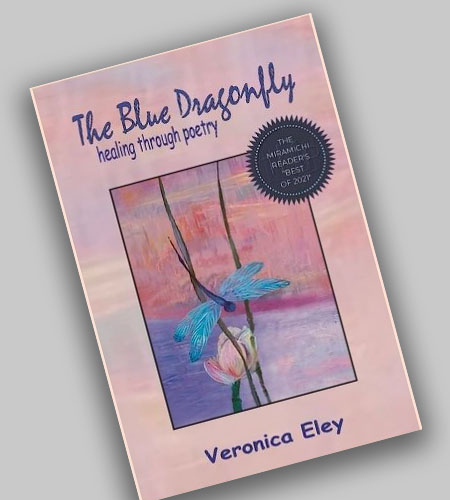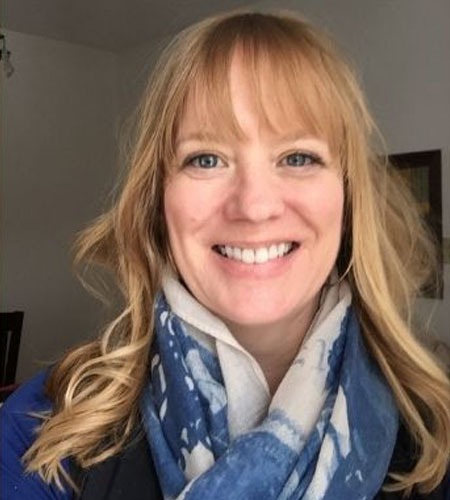Issue Archive
Book Review – The blue dragonfly: Healing through poetry

By Veronica Eley
2021
Hidden Brook Press
Veronica Eley’s The Blue Dragonfly: healing through poetry offers an unusually poignant testament of the poet’s decades-spanning struggle with traumatic after-effects in daily life.
Eley’s poems trace a lifelong struggle with mental illness that first emerges in childhood. By age 7 she was:
“already
showing signs
of emotional
disturbance
bipolar
in today’s terms.”
She portrays her child self as:
“crying
upset
alone”
and prone to tantrums, with
“emotions, whirling
out of control
again
unable to resolve
conflicts
with no centre.”
Poems in this section suggest that her condition may be inherited, and that parental bewilderment (rigidity and indulgence) may exacerbate it. But the second poem in the collection introduces an alternative source for her anguish: in “grey blanket,” the speaker remembers:
“fifteen year old girl
raped
police declare
emotionally disturbed
wrapped
in a grey blanket
taken home.”
The twin trauma of this experience—the rape and the dismissive, invalidating response to it—suggests that to be wrapped in a grey blanket of pain, denial, shame, extends the damage of physical violation with psychosocial sequelae that last well into adulthood.
Rape trauma is but one thread of the knot slowly disentangling across this collection. Living as a “divided self” that fights “secret monsters” is the actual substance of these poems. They raise to the surface the psychological shattering brought about by a broken childhood and half-remembered incest, as well as:
“first sexual experience
rape gang,”
coerced adoption out of a daughter conceived in rebellion, the poet’s own afflicted experience of motherhood tainted by instability –
“with scientific expanded knowledge
they should be able
to thumbprint a bipolar woman
then she could be willingly sterilized”
– and an ongoing sense of terror about the looming onset of psychotic episodes. In “fear of going manic,” she has come to feel herself
“sliding
in and out
of a hole”
—a disturbing and disturbed substitution of her psyche for the penises and other penetrates that have violated her.
Institutionalized as an adult after a psychotic breakdown,
(“I thought I would die
fading, fading
finding me there
the children”)
Eley begins the working through of these experiences in therapy; as discovered by her therapist, she keeps a journal and poems emerge there. These early poems are terse, narrowly formed, devoid of punctuation or music. They run down the page like streams of water wrung from a dishrag—lines are one or two words long, there is no chance to catch breath, the word-drops stop almost as soon as a shimmer of insight arrives. These are poems that seem highly constricted, an imago straining to emerge.
The obvious exception is “natural and man-made consequences,” the breakdown/breakthrough poem of the collection. By far the most viscerally expressive, this poem expresses mental illness rather than speaking about it. The language swerves from cerebral deconstruction of the meaning of “consequences” into “a faded memory” of “BODILY FUNCTIONS”—as many survivors of traumatic experience do, Eley experiences non-cognitive sense memory as her “entry point” into recovering repressed emotions. Attention to smells, textures, flavors, sounds, summons an overload of knowledge that exceeds the rational; the language d/evolves from sense-making to sensing, and for the first time in the collection, sound becomes part of the poems’ meaning. Memories come as flashes of nursery-rhyme-like phrases that play with the taste and texture of words. Visual memories are shown rather than described as the poem comes away from its left margin and re-presents words as they would have appeared: a printed label on a tin of mints signals the habit of a sexual abuser (or victim) to cover up sex-stinking breath with a “Pure Good” heritage personal product—and just like so, a whole history of hidden crimes emanates.
This poem also introduces a recurring image of the “wishbone … caught in my throat”—a symbol of the poet’s struggle to say in words what has been hidden in “the long dark tunnel” of her body/mind for decades. The psychosomatic resemblance of vaginal canal, throat, and this “dark tunnel” makes meaning slippery, both indicative and suggestive, in a strange swirl in and out of feeling and thinking. It is a poem that cracks open new methods of using figurative language to speak what cannot be said.
The sections and poems that follow “natural and man-made consequences” largely trace the process of therapy to correct the “memory loss” that has been Eley’s unconscious coping strategy, a process in which relationships to fellow patients activate the warm beam of empathy (feeling with) that she slowly shines on herself. The word “love” begins to appear in these poems, and the body is for a few moments imagined to be a place of possible sensuality and intimacy. There are regressions (the micro-short lines return), but a shift takes place in which attention to sensory details and discrete observations bring the poet into the current moment and alleviate the anguish of an all-too-present past.
The poems are strongest where they identify these concrete images as evocation of felt knowledge; they weaken where the speaker reports abstract ideas with a sort of off-hand “telling” rather than vivid “showing.” In many ways, these poems remain guarded and coded; they require a patient and committed reader who will slow the flow of the lines and find whole phrases to keep in hand as the poems come forth.
This is, too, the work of the patient/poet: to inhabit with intention and attention what is happening as her internal and external worlds interact. The final sections of the collection, “Stories,” “Memory,” and “Healing,” contain poems that evince a new sense of psychic integration, personal control, and connection to the larger world. At times this larger world is natural, even cosmic, as in several poems about totem-like animals, rain and wind, the sky and the moon and the sun. The poem “ploughing the earth:
a process of poetic transcription” sorts after the fact,
“the process of uncovering
ploughing
digging deep
into fertile ground
the unexpected emotions
feeling the unfelt
memory scapes
the appreciations
of past landscapes
in the back roads
of my mind.”
In these poems, consciousness of the past has mended the holes, and along the way, words have debrided some of those wounds. Pain seems to have lessened, and poems like “full moon” and “changing sky” are spoken by a person who is no longer haunted by mysteries but is now able to find in mystery an occasion for serenity and “prayer.” Eley arrives at “the miracle of perception.”
Across ten sections the poems are deliberately collected to emphasize what is, in editor Roger Langen’s words, their “archetypal” nature, and to present “the storyline for healing: injury, treatment, recovery.” This choice, to construct a narrative arc that assures readers of an inspired though subdued ending, will be effective for the “sanative” reader Langen imagines—the reader who is mostly curious about how traumatized people might rebuild their identities and reclaim their lives.
For the other imagined reader of the book, the “literary” one who “will look for poetry’s exceptional authority to express … extremes in a vivid, imaginative language,” and seek in this collection a treatment of language that refutes and resists any too-easy summation or narrative cohesion – as trauma literature demands – this structure may risk being sentimental, even disingenuous: trauma theory and trauma literature insist that staid notions of “recovery” and “healing” are impossible and even inappropriate for many survivors of traumatic experience. Whatever forms of healing survivors do attain, these are often cyclical and incomplete, tenuous and tender as flesh penetrated by shrapnel that cannot be removed, only lived with.
Thus, presented to promote hope of health regained, these poems arrive at a version of “recovery” that is decidedly not a full-throated chorus of triumphant liberation. Instead, sanity and purpose arrive in quiet contemplation—reverently observed skies and moons and:
“the miracle
of morning light
after the
darkness
of the night.”
In them, escape from pain is provisional, occasional, hard-won; darkness recurs, but so does reprieve from it.
In this recovery, reticence remains. Indeed, readers seeking explicit, confessional detail of confronted-and-processed traumatic experiences will not find them; these poems are reluctant, sometimes maddeningly so. Declarative historical facts of her life are few, and readers must infer context and cause in ways that provoke anxious uncertainty about “reading too much into” the poem’s images and implications. Such is the reality of reading trauma texts that preserve the elusive truths of traumatic loss, instead of feigning testimonial coherence for readers’ sake. Not all readers—even “literary” ones—will have the patience to resolve their own hesitancy to interpret.
But some will, and they will be better for it: As a collection written by a novice to poetry, a person who found in poetry a therapy-based lever for prying open her shattered and broken being, it is a remarkably convincing demonstration of the power of words to rend apart secrets and silences, and to weave together from the shreds a different sort of wholeness. The Blue Dragonfly rewards re-reading, and each poem echoes:
a “stone has fallen into the
water and it is making circles
that connect with each other.”
It is a privilege to watch these connections emerge and to glimpse the poet’s transformation shimmering beneath the surface.
Review by Amy K. Griffiths
Language and Literature
University of Minnesota, Twin Cities

Dr. Amy K. Griffiths earned her doctorate in English at the University of Minnesota in 2011. Her dissertation, “In a Shattered Language”: A Feminist Poetics of Trauma, explores debates within trauma theory as they pertain to self-expression and the role of language in healing for women who have experienced the domestic traumas of rape, incest, and major mental illness. For the past 20 years, Dr. Griffiths has been adjunct faculty at universities in the Twin Cities and Wisconsin, teaching courses on Women Writers, Women’s and Gender Studies, and the Literature of Family Life. She is currently in her second year of study for a Master’s degree in Marriage and Family Therapy. She plans to specialize in work with clients who are survivors of trauma, grief and loss, and to use literature as a treatment intervention to promote their hope and resilience.
